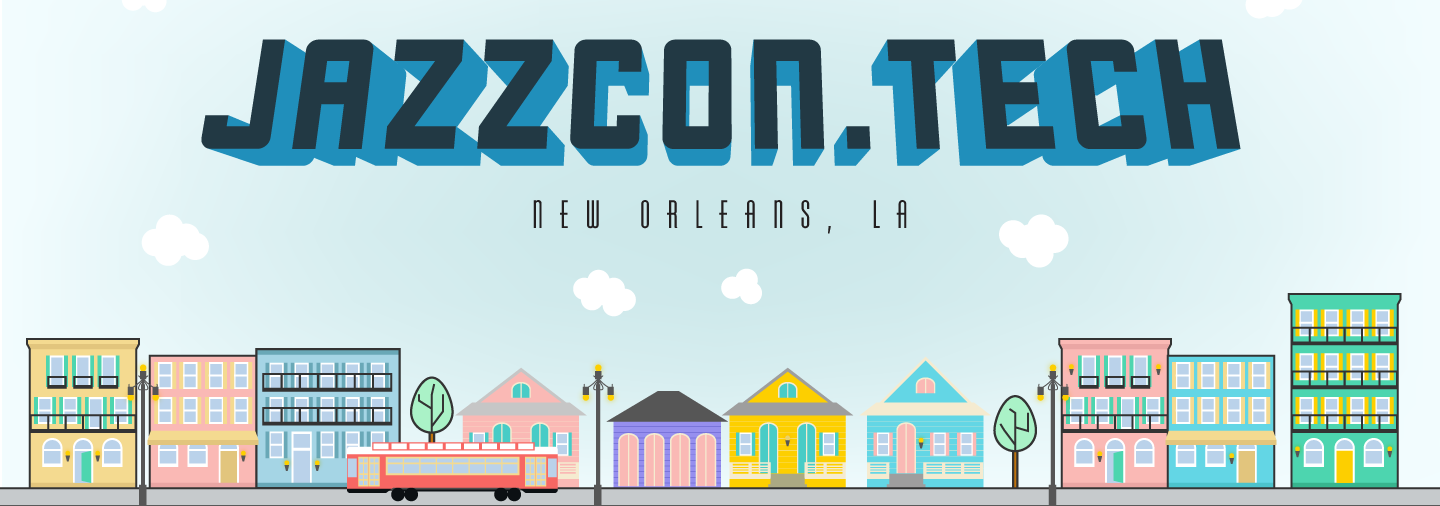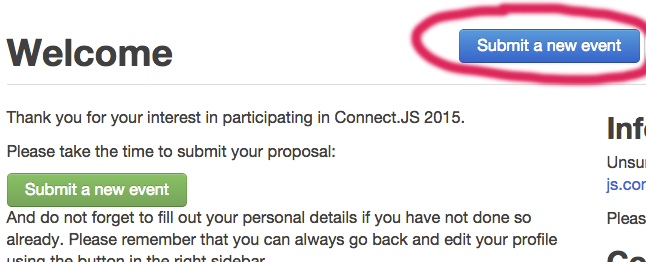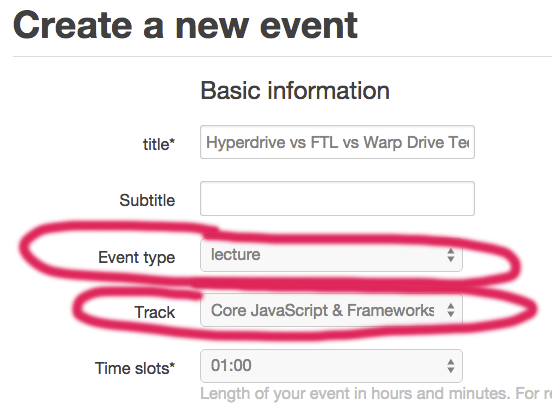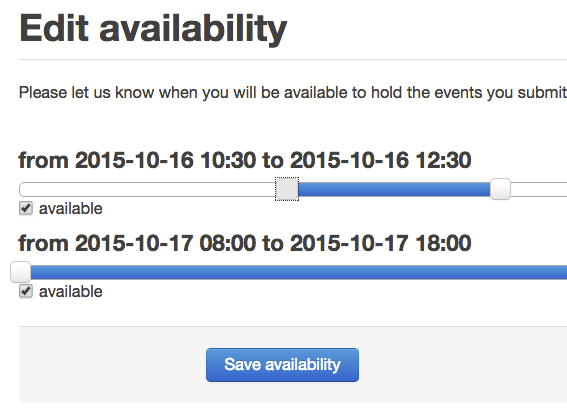Code Of Conduct
JazzCon.Tech is dedicated to providing an outstanding conference experience for all attendees, speakers, sponsors, volunteers and organizers (JazzCon.Tech participants) regardless of gender, sexual orientation, disability, physical appearance, body size, race, religion, financial status, hair color (or hair amount), platform preference, or text editor of choice. We do not tolerate harassment of JazzCon.Tech participants in any form. Please treat your fellow JazzCon.Tech participants with respect, regardless of the context you’re interacting with them.
Harassment is not appropriate for any conference venue. We expect all JazzCon.Tech participants to follow the Code of Conduct during the conference. This includes conference-related social events at off-site locations, and in related online communities and social media. Participants asked to stop any harassing behavior are expected to comply immediately. Conference participants violating this Code of Conduct may be expelled from the conference without a refund, and/or banned from future JazzCon.Tech events, at the discretion of JazzCon.Tech
Examples of harassment include offensive comments, verbal threats or demands, sexualized images in public spaces, intimidation, stalking, harassing photography or recording, sustained disruption of sessions or events, and unwelcome physical contact or sexual attention. Speaker presentations fall under this category and should not use images or examples that would violate the code of conduct.
JazzCon.Tech participants must remember that JazzCon.Tech organizers and volunteers are not trained conflict resolution specialists, nor are they security or law enforcement. JazzCon.Tech organizers and volunteers will immediately escalate issues around safety, violence, or similar situations to Cobb Galleria staff or law enforcement.
For the protection of JazzCon.Tech participants, JazzCon.Tech will never put its organizers or volunteers in the position of trying to assess whether or not an incident merits escalation. If there is any doubt, we will escalate incidents to the appropriate agency immediately.
Incident Resolution
• All JazzCon.Tech participants agree to treat each other with respect, regardless of whether you are in a session room or at the Cobb Galleria facilities.
• Simple disagreements should be resolved between the individuals concerned.
• Harassment or more serious issues should be escalated to a JazzCon.Tech organizer or volunteer. That person will immediately contact a JazzCon.Tech Board member who has the responsibility to assist in resolution.
• JazzCon.Tech participants suffering outright assault or extreme harassment should contact the Cobb Galleria staff immediately, or a JazzCon.Tech organizer if they're nearby. That person will immediately escalate the issue to the Cobb Galleria staff or law enforcement as appropriate.
Unlock: Accessibility and Conversational UI Workshop
Mobile web traffic has outpaced desktop traffic since 2016, and Google now uses your mobile website for search results and SEO. What is your "Mobile First" and "Offline First" architectural strategy to address this?
Mobile web pages, on average, take 22 seconds to load. The average user will wait only a second or two before they abandon your website for the next search result in the list. What is your plan to maximize web performance?
Gartner predicts that 30% of all computer interaction will take place by voice in 2018. Beyond Alexa, Siri, and Cortana, the 1.1 billion people worldwide with a disability expect to be able to fully use your website, including the 253 million users with a vision impairment, and the 108 million users with color blindness. Is your architecture ready to handle a conversational UI? How do you intend to go beyond text and images to fully engage all of your users' senses?
If you are ready to move past the superficial "framework of the week" hype and unlock the full potential of the web platform (as well as your own full potential as a web developer), this full-day, hands-on, lab-driven workshop is for you.
* We'll focus on clean, maintainable, performant, semantic, standards-based, framework-free code.
* We'll use a healthy balance of HTML, CSS, JavaScript, and Web Components.
* We won't waste your time with toy apps like ToDo lists or Twitter clones -- we'll build a fully Responsive, Accessible, Internationalized, Offline-Ready website for a fictitious software conference.
Unlock the full potential of the web platform.
Unlock your website for all devices and all users.
Unlock your future as a standards-based web developer.
Unlock.
Scott Davis is a principal engineer with ThoughtWorks, where he focuses on the leading-edge, innovative, emerging, and nontraditional aspects of web development, such as serverless web apps, mobile web apps (responsive PWAs), HTML5-based smart TV apps, conversational UIs (like Siri and Alexa), and using web technologies to build IoT solutions. He is also the founder of ThirstyHead.com, a Denver-based training and software development consultancy. Scott has been writing about web development for over 10 years. His books include Getting Started with Grails, Groovy Recipes, GIS for Web Developers, The Google Maps API: Adding Where to Your Web Applications, and JBoss at Work. He is also the author of several popular article series at IBM developerWorks, including Mastering MEAN, Mastering Grails, and Practically Groovy. His videos include Architecture of the MEAN Stack, Responsive Mobile Architecture, and On the Road to Angular 2. Scott is also the cofounder of the Denver HTML5 User Group.
Next-level React Workshop: React Router, Redux and more hands-on
This is a full-day workshop on intermediate to advanced topics on building real-world ReactJS Web applications. Basic knowledge of React is required for this workshop. We will start by learning about the core fundamentals of Redux including pure functions, actions, reducers, the store, and subscriptions. Then we will integration Redux into a React app, learning about components vs containers, accessing the store, async actions, middleware, and thunks. Next, we will layer in React Router 4, learning about params, queries, and redirects; prompt before navigation, and scrollToTop. Time permitting and based on audience preferences, we can learn about using component libraries, styling, forms and validations, and more!
Sia Karamalegos is the founder and lead developer Clio + Calliope, a mobile and web design and development firm based in New Orleans. She has over 15 years of experience in technology, strategy, project management, and operations across multiple industries, especially high-tech and education. She also teaches and writes curriculum. Sia was recognized in the Silicon Bayou 100, the 100 most influential and active people in tech and entrepreneurship in Louisiana.
Functional JavaScript With Ramda Workshop
Functional JavaScript with Ramda
Used properly, functional programming means cleaner code, easier maintenance, and simpler testing. But most of us will never use it. Why? Because functional programming is usually explained with jargon, complex math, and some nonsense about monads or whatever. And math is hard, so most of us run away screaming. But here's the thing: functional programming doesn't actually require math. This workshop will teach you how to get the benefits of functional programming today — no math required.
<p>Jason Lengstorf is a developer, designer, author, and friendly bear. He's worked in nearly every role in an agency, from DevOps to sales, and uses his 14+ years of experience to offer a unique, cross-functional approach to solving complex problems. He lives in Austin, TX, spends most of his disposable income on food and travel, and can often be spotted in the forest foraging for nuts and berries.</p>
It's Spelled 'Accessibility', not 'Disability'
Ten years ago -- in the pre-iPhone days -- many companies questioned the need for a mobile-friendly website. Last year, mobile internet traffic surpassed desktop traffic, and many of those same companies are still struggling to catch up.
What does this have to do with Accessibility ("a11y" for short)? The World Wide Web Consortium says, "Accessibility overlaps with other best practices such as mobile web design, device independence, multi-modal interaction, usability, design for older users, and search engine optimization (SEO)." They go on to say, "Users of mobile devices and people with disabilities experience similar barriers when interacting with web content."
What if you could increase your website's SEO, improve your mobile web design, and get a head start on the coming Conversational UI revolution ("Hello Alexa, Siri, Google, and Cortana") through a renewed focus on Accessibility? And what if, while you did it, you increased your user base by potentially 10-20% by making it more accessible to disabled users (1.1 billion people worldwide; 18% of the US population)?
Come hear Scott Davis (Principal Engineer, ThoughtWorks) explain how Accessibility in 2018 should be just as important to you as a mobile design strategy was ten years ago.
Scott Davis is a principal engineer with ThoughtWorks, where he focuses on the leading-edge, innovative, emerging, and nontraditional aspects of web development, such as serverless web apps, mobile web apps (responsive PWAs), HTML5-based smart TV apps, conversational UIs (like Siri and Alexa), and using web technologies to build IoT solutions. He is also the founder of ThirstyHead.com, a Denver-based training and software development consultancy. Scott has been writing about web development for over 10 years. His books include Getting Started with Grails, Groovy Recipes, GIS for Web Developers, The Google Maps API: Adding Where to Your Web Applications, and JBoss at Work. He is also the author of several popular article series at IBM developerWorks, including Mastering MEAN, Mastering Grails, and Practically Groovy. His videos include Architecture of the MEAN Stack, Responsive Mobile Architecture, and On the Road to Angular 2. Scott is also the cofounder of the Denver HTML5 User Group.
What's New in TypeScript?
TypeScript, an open source project, is used to build several key frameworks like AngularJS. This session will cover the latest features of TypeScript 2.x, including future ECMAScript proposals, support for Angular, React/JSX and Node, and the type system capabilities. Doris will demonstrate how TypeScript enables you to leverage features from the current and future of JavaScript while increasing the productivity of JavaScript development for your existing/future projects.
Dr. Doris Chen is a Senior Technology Evangelist at Microsoft, specialized in web technologies (web performance tuning, mobile web, HTML5, JavaScript, TypeScript and Java).
Doris has over 18 years of experience in the software industry working in several open source web tier technologies, Java platform, .NET and distributed computing technologies. She speaks at numerous international conferences and user groups including O’Reilly OSCON, Fluent, Dev Nexus, PHP, HTML5 Dev Conference, WebVisions, JavaOne, SD Forum, and worldwide User Groups. Doris works very closely to create and foster the open source community around Java, NetBeans, Glassfish, and related technologies. Before joining Microsoft, Doris Chen was a Technology Evangelist at Sun Microsystems.
Doris received her Ph.D. from the University of California at Los Angeles (UCLA) in computer engineering, specializing in medical informatics.
Building PWAs for People Terrified of PWAs
A simple, gentle, non-terrifying look at PWAs.
In this talk, I'll introduce people to Progressive Web Apps (PWAs). I'll cover what the term means, what kind of work is involved, and practical tips for building PWAs. I'm new to the topic myself, so my goal here is to help save you from the fear, and pain, I went through! (Trust me though - it isn't nearly as scary as you think!)
Raymond Camden is a developer advocate for IBM. His work focuses on LoopBack, serverless, hybrid mobile development, Node.js, HTML5, and web standards in general. He's a published author and presents at conferences and user groups on a variety of topics. Raymond can be reached at his blog (www.raymondcamden.com), @raymondcamden on Twitter, or via email at raymondcamden@gmail.com.
Why Nobody Fills Out My Forms Part 2: Electric Boogaloo
Still having difficulty encouraging people to fill out web forms to sign up for newsletters, apply for jobs, or complete their online shopping orders? Find out even more tips to help keep people from abandoning early, such as making form field widths more convenient, easing credit card entry, grouping related fields into sections to promote scanning, and styling buttons and controls so your webpage does not look like it was written in 2000.
Andrew is a UI developer and designer at NCR, focusing on POS (point-of-sale) and clienteling solutions. He has two decades of development experience in languages such as JavaScript, Visual Basic, Python, and C, and will admit to having developed a content management solution with Delphi and Perl if backed into a corner.
Font Awesome - Never Build Icons Again
Tired of having to make "delete", "edit", "new", "save", "confirm", and "purchase" icons for your clients? In 3 different sizes (desktop, tablet, mobile)? And new versions for each color scheme you use? Enter Font Awesome! Font Awesome gives you scalable vector icons, that are totally customizable, all by just including a CSS file in your project. It's free, compatible with current devices and browsers, easy to use and customize to your liking. Font Awesome is compatible with Bootstrap, various other frameworks, screen readers, retina displays and cuts down the time you spend doing "boilerplate" work in PhotoShop for every project!
Nolan Erck has been developing software for 19 years, working on a variety of projects from video games to intranets to and web and mobile apps big and small. As a software consultant for the last 10 years, Nolan has worked on projects for CycleGear, Intuit, Hawaiian Electric Company, ZenDesk, Open Table, and others. Nolan also manages the SacInteractive User Group, teaches classes on aspects of software development, and regularly gives presentations at conferences and user groups across the country.
Redux: Architecting and scaling a new web app at The New York Times
In under a year, we scaled NYT Watching from being a brand new React web app to more than a million users per month. Our approach to Redux was a key part of this success, enabling us to manage complex data relationships in an iterative and functional way. In this talk, I will share our approach to implementing Redux for our app – what worked, what didn't, and the many tips and tricks that we’ve learned along the way.
Key takeaways:
- Practical examples of how to organize and update data in your apps using actions and reducers
- Why you should use containers to separate your data logic from your views
- How to increase performance while simplifying data relationships with the use of selectors
- How to deal with different product requirements (specs from Advertising, anyone?) and keep pesky business logic out of your views
- How to integrate query parameters into Redux, and the benefits of doing so
Expect this presentation to use more boxes and arrows than code. I'll use real-world examples based on the challenges my team at The New York Times has faced in the past two years as we used Redux to manage and scale an increasingly complex app.
JC is a Senior Engineer in The New York Times' New Products team, where he leads the development of the NYT Cooking iOS app. Previously he led the development of NYT Watching (TV and movie recommendations app) and NYT Now (a now-retired news app). JC has a BS in Computer Science degree from the Tufts University School of Engineering. Outside of work, he is an opera producer, a classically trained tenor, "studying" for a sommelier certification, and is always looking for new things to learn and do.
Connecting the Dots: How Angular Components Work Together
Picking up a new framework with a new design paradigm can be daunting. You hear familiar names being tossed around (Components, Libraries, Objects), but they're being used in new and mysterious ways. In this talk we'll cover what some of these pieces are, how they're different, how to use them properly, and, most importantly, how they fit together as pieces of a greater whole. Come see why the Angular way of doing things is awesome (and easy).
Scott McAllister has been building web applications in several industries for over a decade. He joined Smartsheet several years ago, building integrations with the Smartsheet API using languages like Java, Node.js, and Python. Now he's helping others learn about a wide range of web technologies. When he's not coding, writing or speaking he enjoys long walks with his wife, skipping rocks with his kids, and is happy whenever Real Salt Lake can manage a win.
How I Cut My Working Hours in Half and Somehow Managed to Get More Done
Three hours. In an average eight-hour workday, the average developer will get maybe three hours of actual work done. Between distractions, interruptions, overloaded schedules, and tight deadlines, it can feel like we'll never get anything done. In this talk, Jason Lengstorf shares his story of grinding out 70–90 hours a week, and the surprisingly simple changes he made to turbocharge his productivity, earn more money, and work an average of 37 hours a week in 2016 — while also rediscovering life outside of work.
<p>Jason Lengstorf is a developer, designer, author, and friendly bear. He's worked in nearly every role in an agency, from DevOps to sales, and uses his 14+ years of experience to offer a unique, cross-functional approach to solving complex problems. He lives in Austin, TX, spends most of his disposable income on food and travel, and can often be spotted in the forest foraging for nuts and berries.</p>
Reactive Programming with Observables
With evolving JavaScript and Angular community, there is a need for a robust solution which can asynchronously handle multiple requests without clogging the incremental flow of the execution. Although, JavaScript offers Promises, Event Emitter or Callbacks to solve the very same purpose, but each has its drawbacks. To handle such asynchronous data streams, we need Reactive Programming. One of the popular feature that has gained a lot of traction in Angular community for handling asynchronous requests, events or data is ‘Observables’. Observables open up a continuous channel of communication in which multiple values of data can be emitted over time.
In this talk we will discuss about Observables, its types and how it is different than ‘Promises’. In addition, the real power of Observables is exhibited by its operators that allows transforming, combining, manipulating, and working with the sequences of items emitted. We will be discussing various operators using RxJS (Reactive Extension of JavaScript), popular library in Angular v2 or higher frameworks for composing asynchronous and event-based programs by using observable sequences.
Purnima Nagpal is a web developer with Masters in Information Technology. She has many years of experience in full-stack and web development, working heavily with Angular 4+, Angular JS, Typescript, JQuery, JavaScript along with Java 8. She is a freelancer and an online trainer. She has also presented a technical paper at TechConn 2017, internal conference at her current company Liquidnet. She is also leading an initiative for 'Tech for Girls' promoting awareness among high school girls and women to get into a technical career. She is highly creative and passionate about front-end development and has written blogs on various topics.
Front-End Performance Still Matters
Help! My app bundle is 5MB! My users are angry that my app is so slow! It’s easy to forget that performance matters when we are under pressure to deliver features quickly. What things should we always do versus only do when performance is slow? What data should we use to inform our decisions? From code splitting, lazy loading, and tree shaking to image optimization and store architecture, come learn how you can deliver a better experience to your users with high-performing front-end apps. This talk uses Webpack and ES6 but is library-agnostic (React, Angular, Vue, etc.).
Sia Karamalegos is the founder and lead developer Clio + Calliope, a mobile and web design and development firm based in New Orleans. She has over 15 years of experience in technology, strategy, project management, and operations across multiple industries, especially high-tech and education. She also teaches and writes curriculum. Sia was recognized in the Silicon Bayou 100, the 100 most influential and active people in tech and entrepreneurship in Louisiana.
Going Beyond "Good Enough" Documentation
"Docs, or it didn't happen," I once heard! "Your code is only as good as your documentation," too. Surely these aren't just adages. In fact, they're the difference between code that's good enough, and code that's so great everyone wants to use it! Learn some of the key ways you can stop hating documentation, and actually get really good at it.
I am versatile nerd with experience that spans front-end development, back-end web development, team management, operations, quality assurance, and technical instruction. In my spare time I garden indoors, snuggle my dog, or can be found cooking or noshing somewhere in Raleigh.
Rockin' the JAMstack with Gatsby
Static site generators are one of the hottest trends right now in front-end development and for good reason. In a world of CMSes, databases, templating engines, and application servers, static sites provide significant benefits to developers, content creators, and consumers alike. Together, we'll explore these benefits while creating a static site using the popular Gatsby static site generator.
Ray Gesualdo is a full-stack JavaScript developer, speaker and mentor from Atlanta, GA. He started his career in the e-learning development industry, working with web-adjacent processes and systems before moving into front end engineering. Currently, he leads the front-end and user experience development at 3Blades, a data science-focused startup. Ray loves working with client- and server-side JavaScript; experimenting with serverless architectures and functional programming; and teaching and equipping others in technology.
Rescuing Legacy UIs: How IBM Is Putting Performance First
Imagine a codebase that loads Dojo, Polymer, jQuery, Angular, _and_ React. Now imagine that you're responsible for making it _fast_. This is the situation our team was up against on the IBM Cloud console.
In this talk, Rizchel will share how her team has improved perceived performance by over 30⨉ in some cases, and brought actual load times down by as much as 250% — using GraphQL, Service Workers, resource preloading, and more — all while shifting the front-end culture at IBM toward performance.
Hi my name is Rizchel and I am a front end developer at IBM. I originally was a back end engineer but switched to front end because of my love for design and UX.
Leadership for the Reluctant Leader
Regardless of the technology you know, regardless of the job title you have, you have amazing potential to impact your family, workplace, community, and beyond. In this talk, I'll share a few candid stories of my career failures... I mean... learning opportunities. You'll walk away with some essential leadership skills I believe anyone can develop, and a good dose of encouragement to be more awesome.
David is a husband, father of 5 boys, software geek, musician, illustrator, and Microsoft MVP living in North GA. He runs on a high-octane mixture of caffeine and JavaScript, and is entirely made of bacon.








